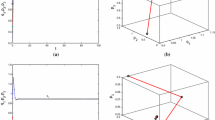Abstract
In this paper, we present a game theoretic framework for Cournot–Bertrand competition based on a nonlinear price function. The competition is between two firms and is assumed to take place in terms of pricing decision and quantity produced. However, the proposed objective function has not been used in literature before, yet the throughput obtained in this paper generalizes some of the existing results in literature. The competitive interaction between firms is described and analyzed using best-reply reaction, proposed adaptive adjustment and bounded rationality approach. The condition of stability of Nash equilibrium (NE) is induced by these approaches. Interestingly, we prove that there exists exactly a unique NE. Furthermore, it is noticed that when firms adopt best-reply and the proposed adaptive adjustment, the firms’ strategic variables become asymptotically stable. On the contrary, when the bounded rationality is used both quantity and price behave chaotically due to bifurcation occurred.














Similar content being viewed by others
References
Arya, A., Mittendorf, B., & Sappington, D. (2008). Outsourcing vertical integration, and price vs. quantity competition. International Journal of Industrial Organization, 26, 1–16.
Bertrand, J. (1883). Review of theorie mathematique de la richesse sociale and recherches sur les principes mathematique de la theorie des richesse. Journal des Savants, 67, 499–508.
Cheng, L. (1985). Comparing Bertrand and Cournot equilibria: A geometric approach. RAND Journal of Economics, 16, 146–152.
Cournot, A. (1838). Recherches sur les principes mathematiques de la theorie des richesses. Paris: Hachette, [translation is available by N. Bacon, New York: Macmillan company, 1927].
Dixit, A. (1986). Comparative statics for oligopoly. International Economic Review, 27, 107–122.
Hackner, J. (2000). A note on price and quantity competition in differentiated oligopolies. Journal of Economic Theory, 93, 233–239.
Kreps, D. M., & Scheinkman, J. A. (1983). Quantity precommitment and Bertrand competition yield Cournot outcomes. The Bell Journal of Economics, 14, 326–337.
Naimzada, A., & Tramontana, F. (2012). Dynamic properties of a Cournot–Bertrand duopoly game with differentiated products. Economic Modelling, 29, 1436–1439.
Shubik, M. (1955). A comparison of treatments of a duopoly problem (part ii). Econometrica, 23(4), 417–431.
Singh, N., & Vives, X. (1984). Price and quantity competition in a differentiated duopoly. RAND Journal of Economics, 15, 546–554.
Tremblay, V., Tremblay, C., & Isariyawongse, K. (2009). Endogenous timing and strategic choice: The Cournot–Bertrand model, working paper. Oregon State University.
Tremblay, V., Tremblay, C., & Isariyawongse, K. (2010). Cournot and Bertrand competition when advertising rotates demand: The case of Honda and Scion. Corvallis: Oregon State University.
Tremblay, V., & Tremblay, C. (2011). The Cournot–Bertrand model and the degree of product differentiation. Economic Letters, 111, 233–235.
Tremblay, C., Tremblay, M., & Tremblay, V. (2011). A general Cournot–Bertrand model with homogenous goods. Theoretical Economics Letters, 1, 38–40.
Vives, X. (1985). On the efficiency of Bertrand and Cournot equilibria with product differentiation. Journal of Economic Theory, 41, 477–491.
Zanchettin, P. (2006). Differentiated duopoly with asymmetric costs. Journal of Economic Management Strategy, 15, 999–1015.
Acknowledgments
This work was supported by King Saud University, Deanship of Scientific Research, College of Science Research Center.
Author information
Authors and Affiliations
Corresponding author
Rights and permissions
About this article
Cite this article
Askar, S.S. On Cournot–Bertrand competition with differentiated products. Ann Oper Res 223, 81–93 (2014). https://doi.org/10.1007/s10479-014-1612-8
Published:
Issue Date:
DOI: https://doi.org/10.1007/s10479-014-1612-8




